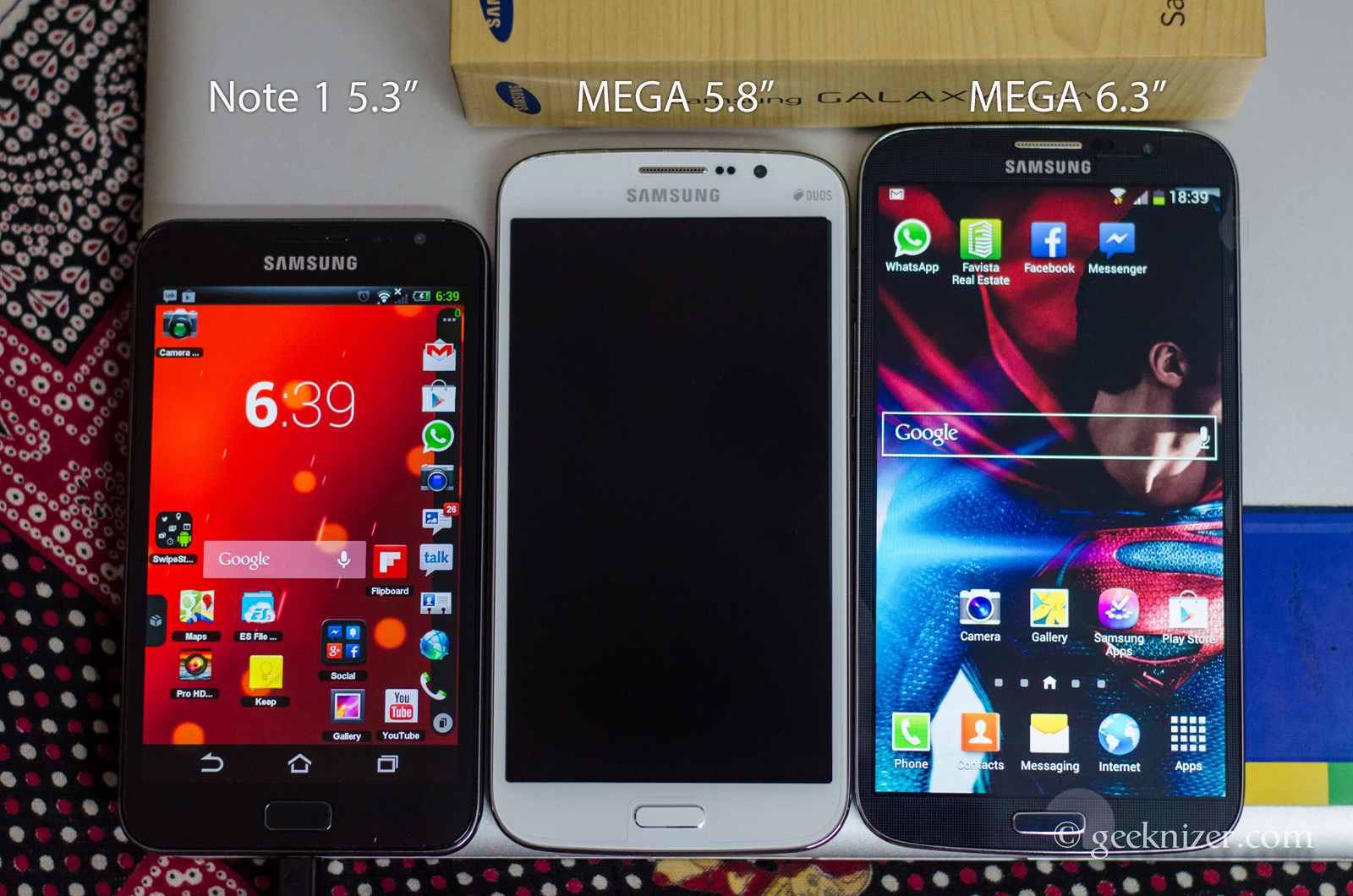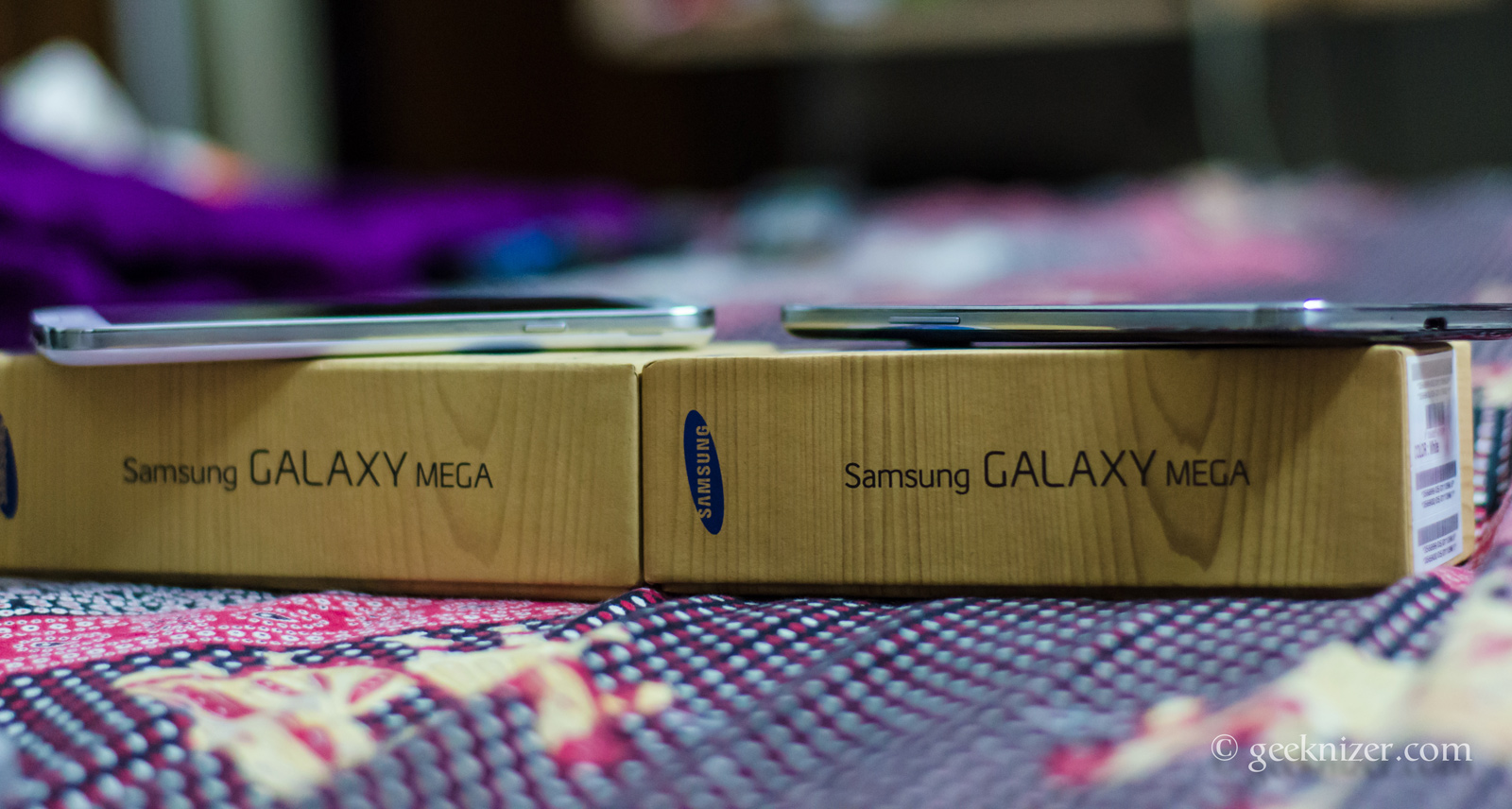Samsung builds the widest range of Smartphone and Tablet screen sizes from 3 inches phones all the way to 11 inches Android Tablets. This includes one of the bravest Phablets like Galaxy Note (5.3″) Note 2 (5.5″) and Tablet/phone hybrids like Galaxy Tab2 (7″).
Joining the race are two new Phablets called Galaxy MEGA 5.8 and MEGA 6.3 inches. We’re fan of Large screen phablets and ever since their launch, Note series have been our favorite.
Both MEGA series phones have been very closely specced and have identical set of apps, that is the reason why we merged the review of these two units into one. Though there is huge difference in their screen and body sizes, cpu, gpu and price points, they are very similar in overall feel.
The Design
The MEGA series sports the elegance and design elements of Galaxy S4, the same small bezel front display with granular pattern in the front and back. The speaker grill, front camera, AirView all live beautifully on the front, however, it is short of motion sensor S4 had in the Front.
On the Rear, you will find the same S4 style detailed pattern printed deep into the flexible plastic removable back.
MEGA 5.8 Specifications
- CPU: 1.4Ghz Dual core Broadcom CPU,
- GPU: VideoCore IV
- GSM: Quad-band GSM/GPRS/EDGE; quad-band 3G with HSPA; LTE; Dual-SIM
- Wifi: Dual-band Wi-Fi a/b/g/n, Wi-Fi Direct and DLNA
- Display: 5.8″ 16M-color qHD (540 x 960) TFT LCD capacitive touchscreen
- OS: Android OS v4.2.2 Jelly Bean with TouchWiz UI
- 1.5GB of RAM
- Camera: 8 MP autofocus camera with LED flash,1080p video recording @ 30fps, continuous autofocus and stereo sound. 1.9 MP front-facing camera, 1080p video recording. Dual shot and dual video recording, Drama shot, Shot and sound
- GPS with A-GPS, GLONASS
- 8GB of built-in storage
- microSD card slot, microUSB port with USB host and MHL
- Bluetooth v4.0
- Accelerometer and proximity sensor, Active noise cancellation with dedicated mic
- Battery: 2,600mAh battery
- 9mm thickness; 180g of weight
MEGA 6.3 Specifications
- CPU: 1.7 Ghz Dual core Snapdragon 400 Krait,
- GPU: Adreno 305
- GSM: Quad-band GSM/GPRS/EDGE; quad-band 3G with HSPA; LTE. HSDPA, 21 Mbps; HSUPA, 5.76 Mbps; LTE, Cat3, 50 Mbps UL, 100 Mbps DL
- Wifi: Dual-band Wi-Fi a/b/g/n, Wi-Fi Direct and DLNA
- Display: 5.8″ 16M-color qHD (540 x 960) TFT LCD capacitive touchscreen
- OS: Android OS v4.2.2 Jelly Bean with TouchWiz UI
- 1.5GB of RAM
- Camera: 8 MP autofocus camera with LED flash,1080p video recording @ 30fps, continuous autofocus and stereo sound. 1.9 MP front-facing camera, 1080p video recording. Dual shot and dual video recording, Drama shot, Shot and sound
- GPS with A-GPS, GLONASS
- 8GB/ 16GB of built-in storage
- microSD card slot, microUSB port with USB host and MHL
- Bluetooth v4.0
- IR port
- Accelerometer and proximity sensor, Active noise cancellation with dedicated mic
- Battery: 3,200mAh battery
- 9mm thickness; 180g of weight
Galaxy Mega 5.8 vs. Mega 6.3
If you haven’t really figured out it already, here are the key differences.
- Display: 960×540 5.8″ display vs. 1280×720 6.3″
- Processor: 1.4Ghz Broadcom CPU vs. Snapdragon 600 dual-core 1.7Ghz
- GPU: Video Core IV vs. Adreno 305
- Battery: 2600 mAh vs. 3200 mAh
- SIM: Dual SIM vs. Single SIM
- Dimensions: 162.6 x 82.4 x 9 mm vs. 167.6 x 88 x 8 mm
- Weight: 182g vs. 199g
- Others: none vs. IR Port.
The Display
Mega 5.8 is more like Grand’s bigger brother with a very lower resolution (960×540) and lower density (190dpi) screen upscaled to a large form factor. The screen pixelates for just about anyone’s eyes, it feels like you’re back to 2nd generation Android phones that had MDPI screens. But Samsung really doesn’t care, they want to make this large screen affordable to just about anyone.
Mega 6.3 has higher resolution screen of 1280×720 at 233ppi, although not adequate for this screen size, but most users won’t notice lack of high pixel density. The LCD screen does a good job at keeping the images and text sharp even at a sub-hdpi pixel density. Unless you’re up-close with the display for pixel-peeping, you won’t have any complains with this display.
Story is developing…
We write latest and greatest in Tech Guides, Apple, iPhone, Tablets, Android, Open Source, Latest in Tech, subscribe to us @geeknizer OR on Facebook Fanpage, Google+.
loading...
loading...


